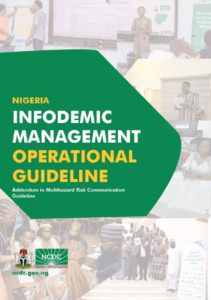The Nigeria Infodemic Management Operational Guideline offers a strategic framework for addressing the spread of misinformation, disinformation, and information overload related to public health threats. Built on five pillars—Coordination, Identification, Simplification, Amplification, and Quantification—the guideline aims to institutionalize infodemic management as a core component of Nigeria’s public health emergency preparedness and response. Developed by the Nigeria Centre for Disease Control and Prevention with key support from Breakthrough ACTION-Nigeria, the document draws on local and international best practices. Breakthrough ACTION provided critical technical assistance in operationalizing social and community listening systems, co-facilitating capacity building efforts, and supporting the Nigeria Infodemic Management Team in developing actionable insight reports. This resource serves as an addendum to Nigeria’s Multi-Hazard Risk Communication Guideline and positions infodemic management as a central feature of the country’s One Health approach.
Nigeria Infodemic Management Operational Guideline: Addendum to Multi-Hazard Risk Communication Guideline
You are here: Home1 / Resource Library2 / Nigeria Infodemic Management Operational Guideline: Addendum to Multi-Hazard...
Web Policies | Sitemap | Contact Us
This website is made possible by the support of the American people through the United States Agency for International Development (USAID). The Breakthrough awards are supported by USAID’s Office of Population and Reproductive Health, Bureau for Global Health, under Cooperative Agreements: #AID-OAA-A-17-00017 and #AID-OAA-A-17-00018. Breakthrough ACTION is based at the Johns Hopkins Bloomberg School of Public Health’s Center for Communication Programs. Breakthrough RESEARCH is based at Population Council. The contents of this website are the sole responsibility of Breakthrough ACTION and Breakthrough RESEARCH. The information provided on this website is not official U.S. Government information and does not necessarily represent the views or positions of USAID, the United States Government, Johns Hopkins University, or Population Council.
© Johns Hopkins University. All rights reserved.


